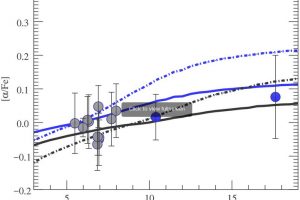Published on A&A: “The Gaia-ESO Survey: radial distribution of abundances in the Galactic disc from open clusters and young-field stars” by L. Magrini

Massive stars are enormous chemical laboratories where heavy chemical elements are synthesized. For instance, the alpha-elements (O, Mg, Si, Ca, and Ti) are produced by nucleosynthetic processes in the interior of massive stars. Moreover, the lifetime of massive stars is much shorter than that of low mass stars: few million years for the former compared to several billion of years for the latter. This means that the heavy chemical elements produced in massive stars are quickly dispersed in the interstellar medium as they explode as supernovae, enriching the hosting galaxy.
The analysis of heavy elements abundances at different positions in the galactic disk can thus reveal vital information on the formation and evolution of the Galaxy. For instance, it is well-known that the abundance of heavy elements decreases with increasing distances from the galactic center. There exist, however, debated observations of clusters in the outer disk rich of heavy elements, which has been interpreted as the consequence of merging of satellite dwarf galaxies with the Milky Way.
This is the contest of “The Gaia-ESO Survey: radial distribution of abundances in the Galactic disc from open clusters and young-field stars“, the study of L. Magrini (Astrophysical Observatory of Arcetri) recently published on Astronomy & Astrophysics, with the participation of F. Damiani and E. Flaccomio (Astronomical Observatory of Palermo). In this paper, chemical abundances of several stellar clusters older than 0.1 Gyears and field stars at different distances from the galactic center are derived through the analysis of the Gaia-ESO survey data. The authors show how existing chemical and dynamical models of the Milky Way reproduce well the observed abundances only in the inner galactic disk. More important, in the paper is discussed how different nucleosynthesis of the various α-elements must be carefully taken into account for a correct interpretation of observed data.
In figure (link) the variation of the abundance of alpha-elements with the galactocentric distance for observed clusters, compared with the prediction of existing models.
